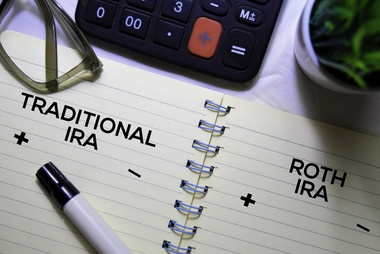The Eternal Question: Roth IRA or Traditional IRA?
Creating a tax-favored savings account is an important part of saving for retirement. The individual retirement account is a popular choice. But IRAs come in two basic flavors: regular and Roth. What are the differences, and which is right for you?
Contributions
The contributions to both traditional IRAs and Roth IRAs are capped at an amount set by the IRS. These limits change annually. Additional rules depend on the type of account:

- In a traditional IRA, contributions are made before taxes are paid. Investments grow tax-free and are not taxed until funds are withdrawn. This makes a traditional IRA a good choice for taxpayers who believe their marginal tax rate during retirement will be lower than it has been during their working years.
- In a Roth IRA, contributions are made after taxes are paid. Investments grow tax-free and are not subject to any further taxes when they are withdrawn. In effect, taxes on the funds in a Roth IRA are prepaid. However, contributions must come from earned income. Income from rentals, interest, pensions or annuities, stock dividends, or capital gains are not permitted.
- In a “backdoor Roth IRA,” the income limits on Roth IRAs are avoided. High-income earners sometimes take advantage of a loophole by opening a traditional IRA and later rolling it over to a Roth IRA. This complex option may be eliminated in future tax legislation.
Withdrawals
- Traditional IRA: Mandatory withdrawals must start by April 1 of the year after you turn 72. The amounts of these mandatory withdrawals, called required minimum distributions, are taxed when they are withdrawn. The RMD amount is calculated by dividing the value of the IRA by a life expectancy factor determined by the IRS.
- Roth IRA: Because contributions are made with after-tax dollars, withdrawals from a Roth IRA are not taxed. In addition, there is no set age for starting to make withdrawals.
Early distributions
- Traditional IRA: Account holders can begin taking money out of the account at the age of 59 1/2. With certain specified exceptions, funds removed before full retirement eligibility incur a 10% penalty on the amount withdrawn and are taxed at standard rates.
- Roth IRA: Because you’ve already paid taxes on your Roth IRA contributions, you can withdraw that money at any time without incurring taxes or penalties. However, you are still subject to a 10% penalty for early withdrawals on earnings in the account.
Diversification
Some taxpayers opt to fund both types of IRAs. Taxpayers who engage in this practice believe they will benefit from having some money in a traditional account in case tax rates go down and having some money in a Roth IRA in case tax rates go up. Anyone thinking about diversifying their retirement savings in this way should carefully examine exactly what their actual benefits will be.
Other options
This article focuses on traditional and Roth IRAs, but other retirement savings vehicles are available, including 401(k) plans, Roth 401(k) plans and Simplified Employee Pension IRAs. Also, there may be other provisions or exceptions applicable to you. The bottom line? Get professional advice before making decisions about retirement savings.


